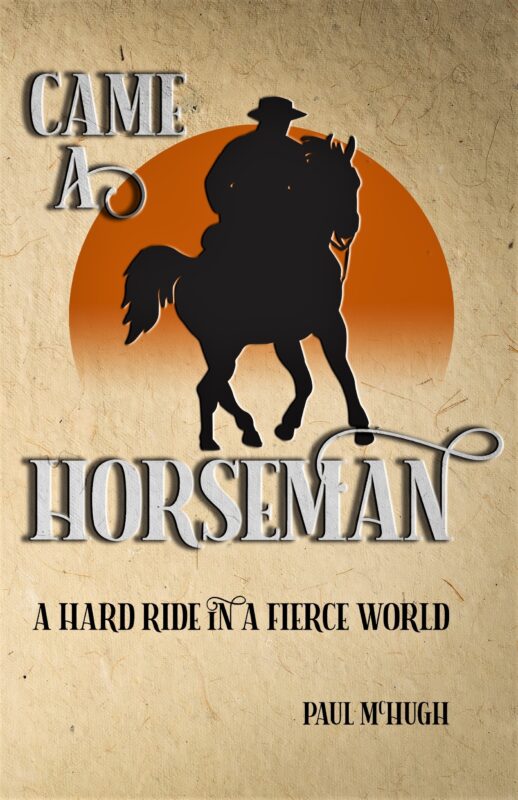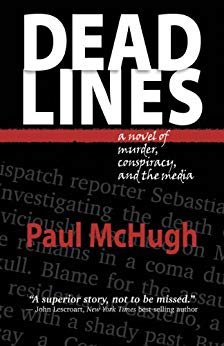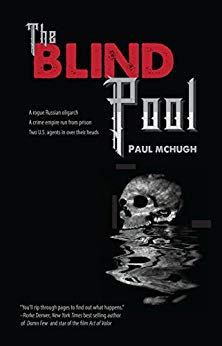San Francisco artist James Gleeson stands in his beautiful backyard garden.

A book’s cover can open a window into a story. Of course, that view should not be a spoiler. So, a good cover ought to tease every bit as much as it tells.
I’m grateful that Bronzeville Books asked San Francisco artist Jim Gleeson to create an original painting for my new World War II novel, “Splinter.” His work does speak rather well to my story. He hints at the book’s opening scenes, then invites a reader to plunge onward into my narrative.
So, in a way, Gleeson’s cover is a visual version of that classic, train conductor’s call, “All aboard…!”

It reminds me of the start of “Through the Looking Glass” (Lewis Carroll’s sequel to “Alice in Wonderland”). In Carroll’s opening, Alice asks her frisky cat, “How would you like to live in a Looking-glass House?” Then, gazing at a mirror above the mantel, she says, “Let’s see if there’s a way of getting through into it, somehow.”
Whereupon Alice enters an alternate reality through a pane of glass while it dissolves into a mist. But in “Splinter,” the alternate reality—brutal conflict—does all the entering. it thrusts itself out through the clear portal and into ordinary life, erupting into a peaceful realm of pre-war Norway.
In “Splinter’s” initial chapter, a German battle cruiser bursts out of mists that hover above waters of Oslo Fjord. That vessel seems to charge toward an early, easy victory in the conquest of Norway. Yet, due to acts of resistance by a force of determined patriots, this particular warship only churns toward its doom. After its sinking, Norwegian survivors of the fracas are able to sail away in a fishing boat.

Though they’re happy to remain afloat, all aboard also stay grimly aware that this is far from the end of an epic struggle. It’s merely the overture for a quite long and operatic fight.
Most of these themes are either captured or implied by Gleeson’s cover.
HOW TO STUDY A STUDIO
Gleeson’s deft piece of work made me feel curious about him, and how he’d managed to nail the assignment. A few weeks ago, I phoned Gleeson and wangled an invite to come visit him in San Francisco.

I parked on a one-way street called Precita, just one block south of Cesar Chavez Street. (Locals could either dub his place a home in the southern Mission or one in northern Bernal Heights—depending on your preference, and whether you were a realtor attempting to sell it.) His place is a beige two-story building with a studio/classroom in the former garage; a living space occupies the floor above.
When I entered his studio, I felt instantly impressed by its tidiness. I’m nobody’s idea of an art expert, although I have befriended a few dedicated paint daubers in the past. Compared to the pigment-speckled dungeons occupied by some of those folks, Gleeson’s HQ seemed to gleam like a high-end gallery in the FiDi (financial district).
After I complimented him on the pervasive sense of order, Gleeson made a dismissive wave with his hand. “Well, last winter, big sheets of rain gushed down the hillside to flood the place.” He pointed at the floor. “So, that forced me to clean up.”

Okay. But his concrete floor appeared freshly painted, with nary a speck of dust to be seen. And the only color spatters around were strictly confined to his canvas apron and his palette.
His studio walls and partitions were hung with rows of watercolors, oils, and—oh hell, I don’t know—works in other media. I’d need to learn a lot more about art to name all his media correctly. But I noted he did manage to show a wide array of styles. They ranged from brooding, black & white noir images, to somewhat abstract, colorful and mildly psychedelic ones. The dominant genre was photo-realism. Images in this category tended to be icons of the San Francisco urban landscape, such as the Balboa Café and Red’s Java House. But even here, some of his visual takes were highly unusual, like the underside of the Central Freeway/I-80/101 interchange.

And I recall thinking, “Now, here’s a gent who broadcasts over some intriguing bandwidth.”
PORTRAIT OF THE ARTIST

Jim Gleeson is lanky, affable man of medium height who sports a wayward shock of greying hair, a neatly trimmed goatee and a ready smile. When we chatted, I felt a sense of connection after he mentioned early on that one of his major influences had been Mort Drucker, the famed Mad Magazine caricaturist. That struck a chord, since Mad’s humor had formed one of the main pressure-escape valves of my adolescence. We riffed for a while on what made Drucker, and Al Jaffee (a Mad colleague) and other caricaturists, such as Al Hirschfeld, so successful.
That opened a door to the topic of Gleeson’s background and training. Mort Drucker himself had been utterly practical about his career. Of his debut at Mad, he said, he “just wanted to be an artist … to get paid for drawing anything.” Once Drucker gained expertise at the magazine’s TV and movie satires, he discovered that he’d found his true calling. Gleeson tackled his own career in a manner that seemed similarly workmanlike and pragmatic.

A San Francisco native and product of the City’s schools, Gleeson says he spontaneously began to draw as a boy. “At first, I did cars and barns, just things. I loved doing it, and I had an affinity for it. Later, I did people. I used to copy from Mad, and then from old black-and-white movie stills, trying to catch the likeness of actors like Bogart and Cagney. I was about 12 when I began that.”
Gleeson said he had the great good fortune to have an uncle, a professional illustrator, who lived with his grandmother, here in the very house that would become his studio. Any time he got stuck on mastering a new technique, he could easily consult his uncle. Another hunk of fabulous luck was that, as an only child, he wound up inheriting his grandmother’s house as well as the one he grew up in.
“That was a great contribution to my career,” Gleeson told me. “Lots of artists get bounced out of San Francisco when they can’t afford a space. But I didn’t need to worry. I always had a base.”
UP, RUNG BY RUNG
At age 19, Gleeson decided he wouldn’t only produce art in his spare time, he wished to achieve durable success as a professional. His Uncle recommended attending the Academy of Art in San Francisco.
“At the academy, they wouldn’t let us paint, for like two years,” Gleeson told me. They forced us to draw, first.”
The rigors of being forced to perfect techniques like line, perspective, outline, edge and shading were important steps toward his goal of mastering every key skill of a working artist.

“It all depends on how you set up your vision. If your light and shadow aren’t correct, your use of color will be limited,” Gleeson said. ”But once your light and dark patterns are established, color can be very powerful.”
He forged on, also studying at the University of San Francisco. Those endeavors were balanced by jobs to earn a livelihood, work at UPS, as well as selling print, advertising and design packages for a leading graphic shop. Eventually, he made a leap and opened his own studio, Jim Gleeson Fine Art Services. These days, his services include teaching classes at the Academy as well as in his studio, selling his prints of San Francisco landmarks, and creating special projects of various sorts. Lucky for me, that latter category does include book covers.
IT’S A WRAP

“Teaching at the Academy is now only about 20 percent of my work,” said Gleeson. “Running my own classes here in the studio is 30 percent. And all the rest comes from my commissions for projects.
“Of those, I’ve done maybe a couple of dozen book covers, beginning with paperbacks for MacMillan. I like them; it gives me a chance to read a book and put my own spin on it. I also truly appreciate art directors who know what they want. I love to pull from all my different skill sets. I can paint like Norman Rockwell or give them a watercolor like John Singer Sargent.”

Gleeson took out a pencil sketch to explain how his design for the “Splinter” cover came together, via discussions with Bronzeville’s art director. First, he wished to establish a horizon line and position the German battleship on it in silhouette. Above the ship is a full moon. That’s not mentioned in my story, but Gleeson explained its pale circle serves as a target, the initial spot a viewer’s eye lands before traveling on. Your eye then picks up more and more information as it moves around the illustration.
Lines of imagery both encourage and direct this movement. Billowing clouds of debris from explosions on the battleship merge into rows of storm clouds that fill a twilit skyscape. These slant across the sails of the fishing trawler, which themselves slant down to the boat’s wake, which then slants back toward the battleship.
“You want a viewer’s eye to stay on the page for a while,” Gleeson commented.
“While they take it all in, think about what might be happening, maybe even imagine themselves in the scene?” I asked.
“Sure,” he replied.

The vivid colors and shapes of the sails, the long white stripe on the fishing boat’s hull, the round portholes that echo the shape of the moon, are all part of an artistic spell that Gleeson has cast. Although this cover scene amounts to a still frame, motion remains strongly suggested throughout.
“The part I like best is that you put the wartime violence in the background. Because if you had it up in the foreground, it might seem flung a bit in a viewer’s face, then make my book feel more like a pulp novel,” I said. “Plus, you drew the fishing boat to look like it’s going to escape. That’s intriguing. The viewer has to wonder how it was involved in the fighting. Or, if.”
Gleeson chuckled. “Yeah, but even if it was involved, now it looks like it’s about to totally get away with it.”
Well, no, not totally, the author thought.
But I’m afraid you’ll have to open Gleeson’s cover, then flip through quite a few more pages, to discover all the adventures that will occur to that fleeing vessel and its occupants. Here’s a place to start.
Postscript
If you find yourself in San Francisco, you can make an appointment to visit Gleeson’s studio and admire his works. Or, if you want San Francisco to come to you, order some of his prints of The City online. Either way, you’re welcome to start getting to know this artist by visiting his website: http://www.jimgleeson.com/









